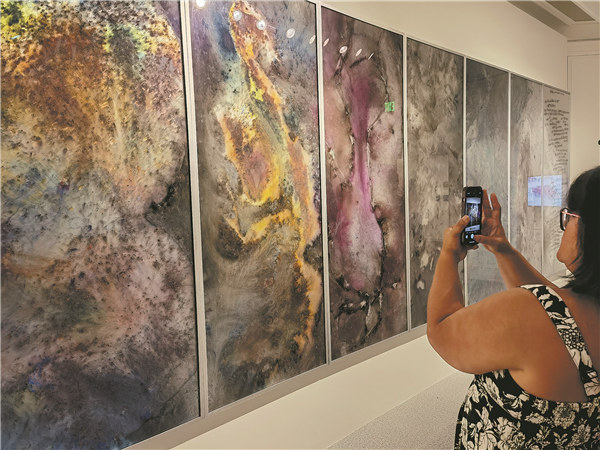

When art meets science, the result can be explosive and revolutionary.
This fusion lies at the heart of Cai Guo-Qiang: A Material Odyssey, an exhibition currently on at the University of Southern California Pacific Asia Museum, which runs until next June.
The exhibition goes beyond the traditional gallery format, merging art with chemistry, physics and artificial intelligence to display the pioneering work of contemporary artist Cai Guo-Qiang, who uses gunpowder in his creations.
"Cai's work is a masterful demonstration of how art and science can converge to create something entirely new," Bethany Montagano, director of USC Museums, told reporters at a preview event on Sept 13.
"We are excited to host this transformative exhibition, which not only celebrates Cai's innovative use of gunpowder, but also highlights the important research and collaboration happening at the intersection of art, science and AI," she says.
A Material Odyssey features a series of gunpowder test pieces produced for the Getty Research Institute to study.
The 67-year-old was born in Quanzhou, Fujian province, and trained in stage design at the Shanghai Theatre Academy in the early 1980s. From December 1986 to September 1995, he worked in Japan and has lived and worked in New York since then.
Best known for his use of gunpowder in intricate paintings, drawings and large-scale pyrotechnic performances, Cai has spent decades pushing the boundaries of art by incorporating volatile materials into his creative process.
These materials have been central to his philosophy and creative practice, symbolizing both destruction and creation.
"I am often inspired by the calmness and the natural strength manifested in the work after the vibrant colors fade. Changes in the gunpowder bring about uncontrollability and unpredictability, which is what makes working with gunpowder so fascinating. The change itself is part of my work," Cai says.
According to Rachel Rivenc, lead curator and head of Conservation and Preservation at the Getty Research Institute, A Material Odyssey highlights something rarely seen in exhibitions: science as a tool for understanding artistic techniques, and presents imagery that explores the molecular behavior of gunpowder, and its evolution as an artistic medium in the artist's hands.
"Cai has embraced the use of gunpowder because he wanted to relinquish control over the creative process. No matter how precisely a gunpowder drawing is planned, the results are still unpredictable," Rivenc says.
"The awe-inspiring nature of Cai Guo-Qiang's work embodies many of the values we hold dear at our museum," says Rebecca Hall, USC PAM curator. "His gunpowder drawings and paintings, when presented alongside the museum's permanent collection and housed in this historic building, remind us that as we push the boundaries of art and science, we remain deeply connected to the wisdom and creativity of the past."
The event serves as a companion to the artist's latest project, WE ARE: Explosion Event for PST ART, which lit up the skies above the Los Angeles Memorial Coliseum on Sept 15. Integrating AI-driven choreography with fireworks, drones and data science, the free daytime performance commissioned by Getty launched PST ART's new theme, Art & Science Collide, in a spectacular fashion.
"Today, with the rapid rise of technologies like AI, culture and the arts often seem powerless. I hope WE ARE will serve as a monumental gesture of how the art world can merge the virtual and real in this new AI-driven era, while also standing as a strong voice and decisive action in these turbulent times," says Cai, who has been researching AI since 2017.
The event was one of the first large-scale daytime fireworks display in the US to incorporate drone formations equipped with pyrotechnic devices, according to Katherine Fleming, president and CEO of the J Paul Getty Trust.